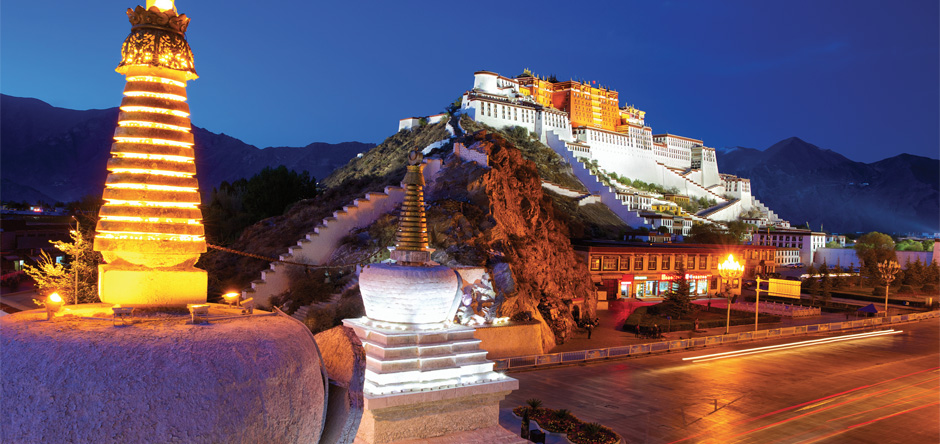Tibetan travel, then and now
Journeying to Tibet on the fast Sky Train is science–fiction compared to 65 years ago. Until 1950, Tibet was a land without wheels. Travel by car, wagon or cart was forbidden for fear of scarring the earth and offending the infinite spirit force believed to dwell in the earth, air and water. Travelers were obliged to walk or ride by yak or pony. Pilgrims would sometimes crawl hundreds of miles on their hands and knees, or measure their length on the ground by prostrating themselves flat and flat again, like silkworms, to view the Potala Palace and worship in the Jokhang Temple, both in the capital city of Lhasa. This feat was called “kyangchhak,” or long prostration, and was considered a high act of holiness promising the rebirth into a better life.
This September, an extension of the railway will open from Lhasa to Shigatse, 155 miles southwest of Lhasa, allowing tourists access to Tibet’s second city – and making an area rich in natural resources easier for China to exploit.
# # #
Riding the Sky Train from Beijing to the mystical kingdom of Tibet is not for the faint of heart. But it is an exciting expedition for those passionate, fast-track adventurers who would get a kick out of whizzing across “the roof of the world” on the highest railroad on the planet to view the “Abode of the Gods.”
The project is considered one of China’s major accomplishments of the 21st century, one popularized by Chinese-Tibeta folk singer Han Hong in the song “Tian Lu” (“Road To Heaven”). The train takes 45 hours to shoot along 1,215 spectacular miles (75 mph), through range upon range of snow-capped Kunlun and Himalayan mountains over the Tanggula Pass — an elevation of 16,649 feet above sea level — through the Fenghuoshan Tunnel and over 675 bridges, balanced on stone columns, laid over 340 miles of permafrost. The excitement rises as the train whizzes through the Kekexili Nature Reserve — home to snow leopards, yaks, Tibetan antelope and wild donkeys. Finally it puffs across the rugged grasslands in the world’s highest alpine valley to Lhasa, traditional home of the Dalai Lamas in Tibet’s ancient capital, and into the intoxicating world of seventh-century palaces, temples and traditions, all immersed in the Buddhist way of life.
Among the 44 train stations, the Tanggula Mountain Railway Station, at 16,627 feet, is the world’s highest. Due to the high elevation, every train carries a doctor. Bombardier Transportation built 361 high-altitude passenger carriages with special oxygen-enriched and UV-protection systems. Fifty-three are luxury sleeper carriages for tourists. Cabin availabilities may vary. Sleeping accommodations generally include semi-private quad occupancy with restrooms in each car.
Tibet is a land in transformation. As the train descends towards Lhasa, the scenery changes. On the grasslands you see the wide chimneys of a refinery and other signs of industrial development that reveal China’s chief reason for building the railway. Improved access to previously remote parts of Tibet will not only increase the volume of tourists drawn by the promise of experiencing an unspoiled and spiritually rich land, but, if all goes to plan, also extract more of Tibet’s largely untapped and abundant natural resources, which China needs to generate its economic growth. The Communist Party values Tibet’s mineral reserves at $96 billion. Mining could make up a third of the region’s GDP.
This, of course, is not without controversy as critics note that Chinese progress has come at the expense of Tibetan autonomy and with the resulting dilution of Tibetan culture.
The city of Lhasa is dominated by the towering red and white Potala Palace, the abode on earth of Chenresik, the living incarnation of Buddha, Lord of Compassion, known in the West as the Dalai Lama. After eight of these god-kings, who once ruled Tibet, entered Nirvana, their earthly bodies, set in the lotus position, were packed in clay, encrusted with gold leaf and enshrined in individual stupas. These golden towers rise from the depths of the castle fortress into a burst of gold on the roof of the Potala Palace. On a sunny day, the blaze can be seen for miles. The 1,300 year-old edifice, containing 999 rooms, was the world’s tallest skyscraper for 300 years and is a masterpiece of architecture.
If any place deserves to be viewed as haunted it is the Potala Palace. For amid the spooky splendor of its myriad benevolent and malicious divinities set in a labyrinth of ceremonial chambers, there have occurred more rich pageantry, secret ceremonies and magical rituals, more sinister intrigue and mysterious happenings than the imagination can encompass.
A great view of the Potala is from the roof of the 13th-century Jokhang Temple of the Precious One, which stands in the heart of old Lhasa, marking the spiritual center of all Tibet. The temple contains Buddhas of the past, present and future, but the most precious one is the seventh-century Sakyamuni Buddha, reputedly brought to Tibet by a Chinese Princess Wen Cheng, who married King Songstsen Gampu, posthumously declared the first Dalai Lama.
Such splendid works confirm the Chinese name for Tibet, Xizang, meaning “Western treasure house.”



